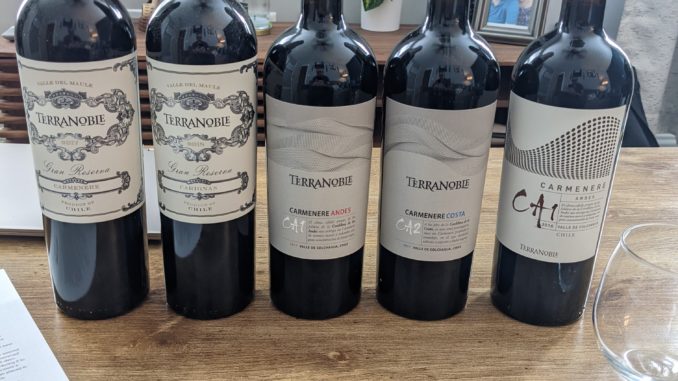
It’s been a while since I got to do a virtual tasting, especially one featuring Carmenere. And, since working from home means that indulging in these kinds of events can be done at any time, I spent a Thursday afternoon sipping on wine recently with about a dozen of my fellow wine bloggers.
TerraNoble Wines
First a little background on TerraNoble. They’re currently in 3 valleys in Chile: the Casablanca and Maule, where they have 1 vineyard each, as well as the Colchagua, where they have 2 vineyards. Between those three vineyards they export about 15,000 cases of wine a year (distributed via WineBow). Roughly 35-40% of their planting is Carmenere, which makes sense given that the grape responds well to warmer weather.
And you can’t talk about wines and warmer weather without talking about climate change (it’s real people). While the warmer growing seasons have been somewhat beneficial to the Carmenere grapes, it’s also impacted the harvest season, moving it up as compared to previous years. It’s also required adaptation in the form of using blankets to protect the grapes from excessive sun and pests such as birds.
All of which leads us to the 5 wines we got to taste: 4 Carmenere and 1 Carignan.
2017 TerraNoble Gran Reserva Carmenere
Made from 100% Carmenere from grapes grown in the Maule Valley. This vineyard is close to the Andes, with soil that’s clayish and of volcanic origin. 75% of the wine was aged for 12 months in previously used French oak barrels, while the other 25% was in untoasted casks, all of which was allowed to age in the bottle for at least 6 months before being sold.
In the glass the wine was a reddish purple color for me. On the nose I picked up aromas of dark fruit and cherry. In the mouth the wine shows tart notes with blackberry, and hints of cocoa with some sweet tannins on the finish.
Unlike the Carmenere I’ve had in the past, there was no green pepper note. I know some people consider those notes a flaw, but it’s something that I rather enjoy. That being said, this was a good way to kick off the tasting.
This wine would pair well with some thick beef ribs or some creamy risotto.
2017 TerraNoble Gran Reserva Carmere – $19 SRP
2016 TerraNoble CA1 Andes Carmenere
Made from 100% Carmenere from grapes grown in the Andes area of the Colchagua Valley. In the glass the 2016 CA1 was a garnet red color with slashes of purple throughout. On the nose I picked up aromas of Herbs de Provence. In the mouth the wine showed flavors of bell pepper, but was smooth throughout.
The 2016 CA1 was probably my favorite wine of the tasting; the smoothness from start to finish made it very easy to sip on (which I did in abundance the following night with our neighbors), but also makes it food friendly.
Pair this wine with meats, risotto, or any dish with lots of seasoning.
2016 TerraNoble CA1 Andes Carmenere – $25 SRP
2017 TerraNoble CA1 Andes Carmenere
Made from 100% Carmenere from grapes grown in the Andes area of the Colchagua Valley. This wine was great to taste because we got to do a baby vertical, having started with the 2016 and then getting to see what difference a year made.
In the glass the 2017 CA1 was more purple than red, while on the nose I got aromas of red fruit and herbs that came out as the wine opened up. In the mouth I got fresh flavors of red fruit with a smooth, gentle finish with just a hint of anise that may come from the clay in the soil where the grapes were grown.
Like most Carmenere, pairing the 2017 CA1 with meats won’t lead to disappointment.
2017 TerraNoble CA1 Andes Carmenere – $25 SRP
2017 TerraNoble CA2 Costa Carmenere
Made from 100% Carmenere in the Costal areas of the Colchagua Valley. Here we got to see the same vintage and valley, but from a different area. While the CA1 was grown more at elevation, the CA2 was grown closer to the water and at a lower elevation, just 40 kilometers from the ocean.
In the glass the wine was reddish, with aromas of tart cherry being prominent. On the palate I got notes of bell pepper and dried fruits with some mineral flavors on the finish.
Compared to the CA1, the CA2 Costa Carmenere was fresher, with fimer tannins. This was my wife’s favorite from the tasting and the one she revisited both that evening while eating dinner, and the following night with friends.
2017 TerraNoble CA2 Costa Carmenere – $25 SRP
2018 TerraNoble Gran Reserva Carignan
Made from 100% Carignan with grapes grown in the Maule Valley. This wine was aged for 10 to 12 months, 50% in a concrete egg (called a Dolia) and 50% in intoasted foudre, all before spendng 6 months in the bottle before being sold.
In the glass the wine was a ruby red colour, and on the nose I got aromas of dark fruit with hints of dried herbs. In the mouth the wine was “zippy”. I got flavors of tart, sour cherry and mineral notes on the finish with just a touch of effervescence.
The 2018 Carignan was very fresh, and would be great on a hot day or paired with strong cheeses, stewed meats, or pastas with tomato sauce.
2018 TerraNoble Gran Reserva Carignan – $19 SRP
Wrapping Up
Big thanks to TerraNoble for an amazing tasting. I’ve done Wines of Chile tastings since shortly after I started writing this blog, and they continue to be well done, fun, and informative.
If you’ve never tried Carmenere you’re really missing out. As the lost Bordeaux grape it’s one you’ve probably had blended into wines from Europe, but Chile does a great job of really featuring the grape and showing what makes it so unique.